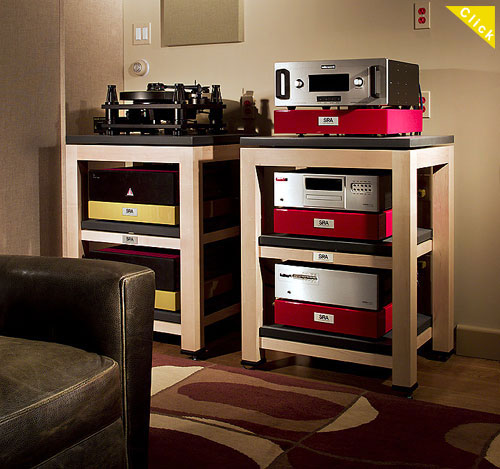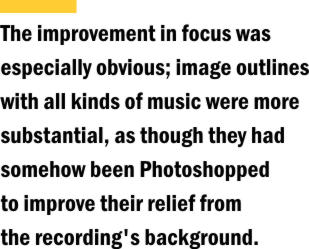Silent Running Audio • Craz² Equipment Rack
udiophiles know Silent Running Audio (SRA) as the maker of equipment racks and platforms, but the company actually has three separate divisions, each with a unique mission but unified by a single aim: isolating sensitive electronics from the deleterious effects of the outside world. In addition to its work in the high-end-audio arena, SRA specializes in military and industrial projects and clinical applications. The company has done extensive work for the US military and hospitals located all over America. Their expertise has even caught the eye of the National Football League.
I can't speculate with any confidence on which part of Silent Running's business is the most profitable, but I do know that the audio wing is a true labor of love for SRA's head, Kevin Tellekamp. Kevin's love of music has driven him to compile a collection of LPs that numbers over 25,000 and to construct a separate building for his audio system, which includes Verity Audio speakers, Audio Research electronics, and a TW-Acustic turntable. Kevin was also a physics and math prodigy. He was doing college-level work before his teens and doctoral work before his twenties. The new version of his Craz equipment rack, the Craz², grew out of exposure to a new suite of testing equipment that, in Kevin's excited words, "was able to measure substrate deflection down to one angstrom!" "I had previously used some of this laser-based equipment during my work on a stealth-aircraft project," Kevin relayed in his understated way, "and before that, with a design team at NASA." Rocket scientists! "After rewriting some software, SRA was able to uncover several small areas of opportunity to improve Craz." Some of these "areas of opportunity" are also addressed in SRA's new, less expensive Scuttle rack. Specifically, Kevin and his crew modified the titanium tubing that's within each Craz rack. Like its predecessor, the Craz² is actually a rack within a rack. What the lovely wood exterior hides is a skeleton of titanium tubing that essentially supports everything that's seen. The titanium tubes are tuned with a series of compounds that SRA chose through computer modeling. Four new compounds were added for the Craz², bringing the total to seven. "As a result, the 'Q,' or sound of the structure itself, is simply not evident," Kevin Tellekamp says. For the previous version of the Craz rack, the titanium rods were inserted into the wood via holes that were drilled the entire length of each support piece, and they were frozen to aid in inserting them. For the Craz², the wooden pieces are cut in half and grooved, the titanium is inserted, and the wood is glued together. The bond that modern adhesives can make is stronger than the materials themselves, and the SRA's woodworking expertise ensures a seamless finish. Other changes include further damping of the four-alloy footer assemblies, which are directly coupled to the inner skeleton. New testing also revealed an opportunity for SRA to improve its "nanoparticle composite" shelving material. According to SRA, this material now comprises "a dense, complex, irregular-void matrix structure made up of microscopic spheres, which now live in a perfect vacuum (as opposed to pockets of air used in the original design), making it impossible for vibration to propagate." Thus, the Craz², and indeed all SRA products, is a many-approach system and employs just about every known principle for addressing vibration. Even so, I asked Kevin Tellekamp to explain his thinking -- the design process behind the Craz². "What equipment are we designing for?" he asked in reply, reminding me of SRA's central tenet: "Component Specific Design," the notion that each SRA rack or platform is built specifically for the products with which it will be used. "This process models hundreds of data entries, resulting in what we call a build-print," Kevin explained, and it is from this that the rack or platform is constructed. Thus, each SRA product is bespoke, "not a cookie-cutter event," in Kevin's words. SRA doesn't maintain inventory of finished products; they have no idea what they'll be building next. This necessarily means that pricing is difficult to quote, as it depends on a number of factors. The closest SRA comes to stock models of the Craz² are the Three and Six, which get their names from the number of components they can accommodate. These are $11,500 and $13,500 respectively. Both have three shelves, but those of the Six are wide enough to place equipment side by side. The rack I received for review and wrote about in my blog, "Chess Boxing with a Craz²," has four shelves and room for eight components. It would cost $15,500. "Almost any dimensions/configurations are possible," according to Kevin. Putting aside all of the technical considerations, I will say that the Craz² is a lovely thing to behold, mostly due to the proportions of its parts and the grain of the wood. Its Shaker-like simplicity and earthiness are welcome alternatives to the metal-and-glass glitz of other racks. Hard white maple, sapele mahogany and cherry are the woods that SRA uses most often, but other dense woods are available on special order. A clear-coat finish is standard, but I've seen SRA racks with paint washes and even faux-veneer finishes -- SRA can create just about any finish and even make one wood look just like another. The machining of all wooden pieces is done on a five-axis CNC mill, which means tolerances are extremely tight -- thousandths of an inch. Each 1 3/4"- or 2 3/4"-square wooden piece starts off as a 12" blank that has air dried for 15 years. The special shelves are decoupled from the frame by squishy black pods that are a combination of acrylic and thermal-reactive urethanes that are stable over a range of temperature and humidity conditions. These rest on cross braces of different materials that are chosen based on the equipment on each shelf. The materials include titanium, T-6 aluminum, and HY-80 high-tensile steel, and the cross braces can be fashioned from a combination of them. All of this makes for a rack that's a bulwark against vibration and resonance. Once leveled and spiked, the Craz² feels as though it's anchored in bedrock. There isn't even a fraction of an iota of play in the frame, and once the shelves are added, the rack's sheer mass means it's not going anywhere. Because of all the product-specific forethought that goes into each SRA rack, Kevin Tellekamp doesn't recommend the use of aftermarket pucks or cones under components. And from a great deal of experience, I have to agree with him for the most part, as no cone or footer that I've used made a discernible change, let alone one for the better. The one exception (among the many devices I've used, that is) is from Ayre Acoustics -- the myrtle-wood blocks Ayre touts for use with its products. My guess is that these inexpensive wooden blocks, used in groups of three, somehow aid in the transfer of vibrational energy out of the product's chassis in a way that's copacetic with the rack's design. Or something like that. Whatever the case may be, I know that Kevin will frown as deeply on these as he does on every product like them, but I hear what I hear, and I still think they're worth trying. The sound of silence ften relegated to the status of a mere accessory, an equipment rack is an overlooked part of the conglomeration of products we call an audio system. There are no drivers or tubes, no inputs or outputs, no on/off switch or remote control. The only periodic maintenance a rack requires is dusting. It's easy to forget about it -- something I've done many times at shows, anxious to get a picture of a new preamp or turntable and simply not seeing what these items were sitting on. In some cases, however, such disregard was warranted. There are two kinds of equipment racks: those that merely support components and those that squeeze the greatest performance out of them. The first is an accessory, while the second is integral to an audio system's sonic performance. The Craz² sits firmly in the latter camp. The magnitude of the sonic gains for which it is responsible means it becomes an indispensable piece of an audio system -- just like those that have drivers, tubes and on/off switches. The improvement in focus -- the system's ability to portray instruments and singers with ultimate solidity and resolution -- was matched by a peculiar sense of calm, the music sounding relaxed, yes, but also as though the microdynamic depths of each recording were finally reached.
I purposely listened to CDs first, thinking that this would provide a sonic baseline for the electronics before moving to analog. Because analog playback is based on the microscopic movement of the stylus followed by an immense amount of gain, the outside world can exert great effect on the sonic result. But the Craz² isolates the turntable from its environment, and it is a very effective sink for any self-created noise. Combined, these things ensure that an analog setup will sound exactly as it should under ideal conditions -- no surprise, I suppose, given that Kevin Tellekamp is an analog diehard. With LPs, the Craz² performed sonic miracles. The stereo spread was wider and the mono stage better layered and more material. Attack was fierce and decay trails stretched further into the void of the noise floor. This was literally the case with every LP, but most obvious with the best of them -- both in terms of sonics and pressing quality. Diana Krall's Live in Paris [Verve/Original Recordings Group 440065] is an astonishingly open, lithe recording that's pressed on first-rate Pallas vinyl. It achieved true holography once the Craz² was under my TW-Acustic turntable. Instrumental textures were conspicuous, as was the breathy quality of Krall's voice. I was reminded of what the Shunyata Research power cords and power conditioner do in my system, yet convinced that they are more complementary with the Craz² than doubling the perceived strengths of both. The noise floor with the Craz² wasn't so much deeper as finer and blacker, akin to that of the Ayre MX-R amps. I was so impressed by what I was hearing -- Diana Krall never sounding more physical and dimensional -- and so curious to discover what might be behind it that I pulled out a stethoscope (don't laugh -- every reviewer should have one) and confirmed that the noise of the turntable's motor and even the infinitesimal friction of its bearing were making their way down into the Craz²'s top shelf but no further. The damping pods as well as the rack's entire noise-draining system were obviously doing their job. As time went on and I experimented by removing components from the Craz² and then putting them back again, just to hear the difference, I understood more about what I was hearing. The Craz² wasn't adding anything to the music, but it certainly was removing a great deal from it. The sound took on the sort of quality that follows a thunderstorm here in the desert: the view is more vivid, not so much scrubbed clean but devoid of particles carried in the air that cast a fine haze. With that haze gone, everything looks purer, more like itself. With the Craz², the same was true of every piece of electronics and the music they made. Nothing escaped the Craz²'s isolating caress. To the cloud
A friend of mine owns an early version of the SRA Craz
rack, and he considers it the one indispensable part of his audio system. "Everything
else can come and go, but the Craz will stay," he has said to me. This may seem like
folly or hubris, but once you have a Craz² in your system, you'll know what he means.
|


 The improvement in focus was
especially obvious; image outlines with all kinds of music were more substantial, as
though they had somehow been Photoshopped to improve their relief from the recording's
background. I often listen to the recordings of a certain performer in bunches, committed
to not just appreciating the music but understanding the creative impulses behind it. No
jazz pianist requires greater commitment than Thelonious Monk, and I was on a Monk jag
when the Craz² arrived. While it's easy to love the idiosyncrasy of Monk's own
compositions, one of my favorite Monk recordings is Plays Duke Ellington [Riverside
RCD-201-2], a collection of (what else?) Ellington covers. This CD has limited bandwidth
and its tonality is somewhat chalky, so Monk's piano has to carry the performance.
With all of the electronics on the Craz², the piano achieved supreme clarity throughout
its range. However, it was the intensity of attack of each note that made the SRA rack's
presence known, the piano ringing with heightened vitality, expressing Monk's incomparable
pacing and phrasing all the better.
The improvement in focus was
especially obvious; image outlines with all kinds of music were more substantial, as
though they had somehow been Photoshopped to improve their relief from the recording's
background. I often listen to the recordings of a certain performer in bunches, committed
to not just appreciating the music but understanding the creative impulses behind it. No
jazz pianist requires greater commitment than Thelonious Monk, and I was on a Monk jag
when the Craz² arrived. While it's easy to love the idiosyncrasy of Monk's own
compositions, one of my favorite Monk recordings is Plays Duke Ellington [Riverside
RCD-201-2], a collection of (what else?) Ellington covers. This CD has limited bandwidth
and its tonality is somewhat chalky, so Monk's piano has to carry the performance.
With all of the electronics on the Craz², the piano achieved supreme clarity throughout
its range. However, it was the intensity of attack of each note that made the SRA rack's
presence known, the piano ringing with heightened vitality, expressing Monk's incomparable
pacing and phrasing all the better. hile you don't plug it in
or connect it to the rest of the system, the Craz² offers the same level of sonic
improvement that the other pieces of an audio system do. This is certainly due to the way
it cuts off the electronics -- especially the turntable -- from airborne and
structure-borne vibration. It also deals directly with the components that rest on it,
draining their chassis of microvibration and resonance that affect the sonic outcome in
amusical ways. Don't let the good looks of the Craz² divert your attention from its
primary purpose: to help your audio system achieve its very best performance. If you have
a turntable, prepare to be astounded by the heights it is able to achieve.
hile you don't plug it in
or connect it to the rest of the system, the Craz² offers the same level of sonic
improvement that the other pieces of an audio system do. This is certainly due to the way
it cuts off the electronics -- especially the turntable -- from airborne and
structure-borne vibration. It also deals directly with the components that rest on it,
draining their chassis of microvibration and resonance that affect the sonic outcome in
amusical ways. Don't let the good looks of the Craz² divert your attention from its
primary purpose: to help your audio system achieve its very best performance. If you have
a turntable, prepare to be astounded by the heights it is able to achieve.